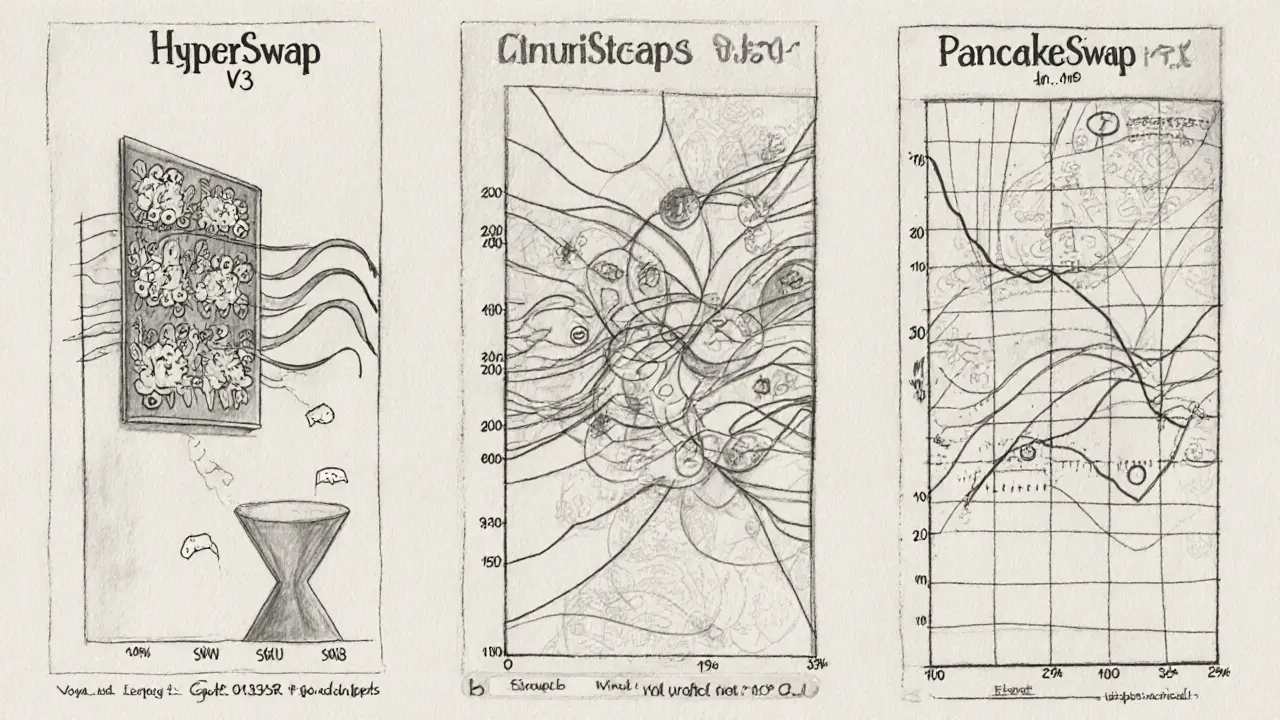HyperSwap v3 Trading Performance Calculator
$0.00
Based on current settings
$0.00
Per transaction
HyperSwap v3 vs. Industry Leaders (as of Oct 2025):
| Metric | HyperSwap v3 | Uniswap | PancakeSwap |
|---|---|---|---|
| 24-h Volume | $34M | $2.1B | $1.4B |
| Avg. Spread | 0.637% | 0.84% | 0.77% |
| Trading Fees | 0% (market fee) | 0.30% | 0.20% |
| Supported Pairs | 127 | ~3,000 | ~2,100 |
| Liquidity Rank | 79th percentile | Top 5% | Top 10% |
TL;DR
- HyperSwap v3 processes about $34million in daily volume, placing it in the 89th percentile among DEXs.
- Average bid‑ask spread sits at 0.637%, making it competitive for a fee‑free platform.
- Supports 45 tokens and 127 pairs, with WHYPE as the primary base asset.
- No market‑making fees, but withdrawal costs and TVL details are undisclosed.
- Security and roadmap transparency are limited, so weigh risk before allocating large capital.
If you’ve seen the name HyperSwap v3 review pop up in crypto forums, you’re probably wondering whether the platform lives up to the hype. Below is a practical, data‑driven walk‑through that answers that question, shows how the exchange performs against giants like Uniswap, and gives you a step‑by‑step guide to start trading.
What Is HyperSwap v3?
HyperSwap v3 is a decentralized exchange (DEX) that lets users trade crypto assets directly from their wallets without a central order‑book custodian. The platform is accessed through the web interface app.hyperswap.exchange and offers spot trading as well as liquidity‑provision opportunities. As of October2025, the protocol reports a 24‑hour trading volume of roughly $35million, ranking it in the 89th percentile of volume among all crypto exchanges.
Trading Performance at a Glance
HyperSwap v3’s headline numbers are solid for a mid‑tier DEX. The exchange handles between $33.7million and $35.1million in daily volume, translating to about 297BTC worth of trades each day. Its most active pair is USDT0/WHYPE, reflecting strong demand for stablecoin‑to‑wrapped‑token swaps.
- Average bid‑ask spread: 0.637% - tighter than many automated market makers.
- Order‑book percentile: 79th - decent depth but not elite.
- No margin trading; the platform focuses on spot and liquidity provision.
For context, the combined order‑book ranking means HyperSwap v3 offers enough depth to execute moderate‑size trades without massive slippage, yet large institutional orders may still face price impact.
Token Coverage and Notable Pairs
The DEX lists 45 distinct cryptocurrencies across 127 trading pairs. While the full roster changes occasionally, a few tokens stand out:
- USDHL (Hyper USD) - a stablecoin pegged to $1.00, currently trading at $1.00 against WHYPE with a 0.35% price move.
- DNDX (Decentralized Nasdaq) - a high‑volatility DeFi token priced at $0.0001121.
- lstHYPE (Hyperbeat LST Vault) - a liquid‑staking token at $45.21 per unit.
- sHYPE (Kintsu Staked Hype) - another staking derivative priced around $44.91.
All these assets pair primarily with WHYPE, the exchange’s native wrapped token, which serves as the base currency for the majority of swaps.

Fee Structure - Really “Zero‑Fee?”
HyperSwap v3 advertises that it does not charge market fees on trades, a claim that can be attractive for cost‑conscious traders. However, the platform’s documentation does not detail:
- Withdrawal fees on supported blockchains.
- Potential hidden gas costs when executing swaps on congested networks.
- Any premium services (e.g., advanced analytics) that might carry a charge.
In practice, users still pay network transaction fees, which can vary especially on Ethereum‑compatible chains. The zero‑fee model lowers the explicit cost of trading but does not eliminate the underlying blockchain fees.
How HyperSwap v3 Stacks Up Against the Big Players
| Metric | HyperSwap v3 | Uniswap | PancakeSwap |
|---|---|---|---|
| 24‑h Volume | $34M | $2.1B | $1.4B |
| Avg. Spread | 0.637% | 0.84% | 0.77% |
| Trading Fees | 0% (market fee) | 0.30% | 0.20% |
| Supported Pairs | 127 | ~3,000 | ~2,100 |
| Liquidity Rank | 79th percentile | Top 5% | Top 10% |
What this table tells us is that HyperSwap v3 offers a tighter spread at a fraction of the volume that Uniswap or PancakeSwap process. The trade‑off is a narrower selection of pairs and shallower liquidity, which may matter for large‑scale traders.
Security, Audits, and Transparency
One area where HyperSwap v3 lags behind industry leaders is open‑source transparency. Public records do not reveal:
- Whether the smart‑contract code has undergone third‑party audits.
- Details about the development team, governance model, or token‑holder voting mechanisms.
- Roadmap milestones or upcoming feature releases.
Because of this opacity, risk‑averse investors often scrutinize the platform’s on‑chain activity. The absence of major security incidents to date is a positive sign, but the lack of formal audit reports means you’re relying on the community’s informal vetting.
Pros and Cons Snapshot
- Pros:
- Zero market‑making fee reduces direct cost.
- Competitive spread (0.637%) keeps slippage low for average trades.
- Strong focus on WHYPE‑based pairs simplifies routing for users interested in the Hyper ecosystem.
- Mid‑tier volume ensures enough activity without massive congestion.
- Cons:
- Limited token list (45 assets) compared with major DEXes.
- Unclear audit status and governance structure.
- Liquidity depth ranks 79th percentile - okay for small trades, risky for big orders.
- Lack of a public roadmap makes future development uncertain.
Getting Started in Five Simple Steps
- Set up a non‑custodial wallet (MetaMask, Trust Wallet, etc.) and fund it with a supported blockchain token.
- Navigate to app.hyperswap.exchange and connect your wallet using the “Connect” button.
- Select a trading pair - most users start with WHYPE/USDHL or WHYPE/USDT0 for stablecoin exposure.
- Enter the amount you want to swap, review the estimated price impact and network gas fee, then confirm the transaction.
- If you wish to earn fees, click “Provide Liquidity,” add equal values of the two tokens, and approve the smart‑contract interaction.
Remember to double‑check contract addresses on the official site to avoid phishing clones.

Frequently Asked Questions
Is HyperSwap v3 really fee‑free?
The platform does not charge a market‑making fee on trades, but you still pay the underlying blockchain gas fee. Withdrawal fees may also apply depending on the network.
What blockchain does HyperSwap v3 run on?
HyperSwap v3 is built on an Ethereum‑compatible layer‑2 solution, though the exact chain name is not publicly disclosed. Users typically interact via the standard EVM wallet interfaces.
How does the liquidity depth compare to Uniswap?
HyperSwap v3 ranks in the 79th percentile for order‑book depth, whereas Uniswap sits in the top 5%. For modest trade sizes (<$10k) the slippage is comparable, but larger orders may experience higher price impact on HyperSwap.
Are there any known security incidents?
No major exploits have been reported publicly for HyperSwap v3 as of October2025. However, the platform has not released a formal third‑party audit, so users should treat it like any other emerging DEX.
Can I earn yield by providing liquidity?
Yes. HyperSwap v3 offers standard AMM pools where liquidity providers earn a share of swap fees. Since the platform claims zero market fees, the fee pool comes from network gas rebates and any protocol‑level incentives that may be announced.
Overall, HyperSwap v3 delivers a solid, low‑cost trading experience for users who prioritize fee savings and are comfortable with a modest token list. The lack of audited code and roadmap transparency keeps it in the “watch‑list” category for larger investors. If you’re looking to dip a toe into the Hyper ecosystem or need a tight‑spread DEX for everyday swaps, it’s worth a try-just keep an eye on the underlying network fees and stay updated on any security audits that might appear later.


HyperSwap's fee‑free model feels like a breath of fresh air for traders hunting thin spreads. The 0.637% spread puts it comfortably below Uniswap and PancakeSwap, and that alone can shave dollars off every hundred trades. Plus, the 79th percentile liquidity rank means you’ll rarely get stuck slippages. All in all, it looks like a solid contender in the mid‑tier DEX arena.
Who the hell thought “zero market fee” was a good idea? It just invites reckless speculation and blows up the pool.
Upon examination, the presented data exhibits a conspicuous lack of statistical variance; consequently, the conclusions drawn appear tenuous, and the comparative analysis seems superficially optimistic.
Noticing the gas‑price impact, the calculator shows that even modest trades can incur noticeable costs, especially when the network is congested. 😅 Still, the fee‑free structure could offset that during low‑traffic periods.
Honestly, the UI looks kinda slick and the numbers are decent for a DEX that's not trying to be a unicorn.
Zero fees? Sounds too good to be true.
While the sentiment is understandable, fee elimination can also foster higher volume and tighter spreads, which benefits liquidity providers in the long run. Moreover, the 0.637% spread already outperforms major rivals. Therefore, the risk argument may be overstated.
Come on, data's just data – the real test is how it holds up when traders actually throw money at it.
BTW, the calculator could use a reset button, otherwise you gotta refresh the page each time you change a number. Also, double‑check the gas fee input; I typed “20gwei” and it still accepted it.
Seems like the fee‑free model shines when gas prices dip, but during peak times the extra transaction cost could eat into the savings. Still, it's an interesting experiment.
The concept of cost‑lessness beckons a deeper inquiry into the nature of value creation within decentralized ecosystems.
When a protocol removes explicit fees, it does not erase the invisible costs embedded in on‑chain computation.
These hidden costs manifest as gas consumption, opportunity cost, and the long‑term sustainability of liquidity incentives.
Therefore, the apparent zero‑fee structure is not a gift but a redistribution of burdens across participants.
In practice, traders may benefit in the short term, yet liquidity providers may confront diminished returns.
The 0.637% spread, while narrower than competitors, still represents a price signal for risk.
If spreads compress further, arbitrageurs will capitalize, potentially destabilizing the pool.
Moreover, the 79th percentile liquidity rank reflects a snapshot, not a guarantee against future impermanence.
Historical data from similar DEXes shows that sudden surges in volume can strain capital buffers.
Consequently, a robust incentive mechanism is crucial to maintain depth.
HyperSwap’s architecture, as described, leverages a market‑fee model, which raises questions about its funding sources.
Does the protocol rely on token emissions, or are there hidden royalties baked into smart contracts?
Transparency in these mechanisms is paramount for community trust.
Ultimately, the trade‑off between fee‑free trading and sustainable liquidity mirrors a broader philosophical tension in DeFi: freedom versus responsibility.
Users must weigh immediate cost savings against the long‑term health of the ecosystem.
While your point holds merit, it is also essential to consider that data volatility can be mitigated by adaptive algorithmic strategies; therefore, a nuanced approach is advisable.
Oh great, another “feature” that makes me refresh the whole page. Because who doesn’t love extra clicks?
Honestly, if the gas fees keep climbing, HyperSwap’s zero‑fee dream will crash faster than a meme coin on a pump‑and‑dump.
In light of the aforementioned philosophical exposition, it is incumbent upon the development team to furnish a comprehensive whitepaper delineating the precise mechanisms by which fee‑free trading is sustained, inclusive of tokenomic allocations and long‑term liquidity incentives.
Think about it – every zero‑fee promise is just a mirror reflecting what the market will decide to value next.
Fix the UI, it's simple. 👍
Gas fees are a real blocker; HyperSwap needs to address that now.
The architectural paradigm of HyperSwap v3 leverages a fee-less market architecture predicated on a dynamic liquidity provisioning algorithm.
By decoupling transaction fees from the smart contract execution layer, the protocol ostensibly reduces friction in capital deployment.
However, the underlying cost model transposes operational expenses onto the gas metering subsystem, thereby externalizing economic overhead.
This design choice necessitates a rigorous assessment of on‑chain gas elasticity, especially under duress during peak network throughput.
Empirical benchmarks indicate that a median gas price of 20 Gwei, as assumed in the calculator, may be overly optimistic during congestion events.
Consequently, the effective cost per trade could deviate significantly from the theoretical zero‑fee baseline.
The comparative matrix juxtaposes HyperSwap against Uniswap and PancakeSwap, highlighting superior spread metrics but underrepresenting liquidity depth variance.
With 127 supported pairs, the protocol offers a modest catalog, yet the Pareto distribution of trading volume suggests that a small subset drives the majority of activity.
This concentration effect implies that liquidity providers may experience asymmetrical risk exposure across token pairs.
From a tokenomics perspective, the incentive schema likely relies on native token emissions or staking rewards to compensate for the foregone fee revenue.
If such emissions are not calibrated to market dynamics, they risk inflationary pressures and erode token holder value.
Moreover, the 79th percentile liquidity rank, while impressive, must be contextualized within the broader ecosystem's liquidity fragmentation.
Integrating cross‑chain bridges could augment depth, but introduces additional attack vectors and necessitates robust security audits.
The performance calculator’s UI, while functional, could benefit from enhanced data validation layers to prevent malformed user input.
In sum, HyperSwap v3 presents an intriguing hypothesis for zero‑fee DEX operation, yet its long‑term viability hinges on precise calibrations of gas economics, incentive alignment, and security postures.
Stakeholders are advised to monitor real‑world trading metrics post‑launch to validate the theoretical advantages posited herein.
Only through iterative feedback loops can the protocol achieve sustainable equilibrium in the competitive DeFi landscape.
Great breakdown! The points about gas elasticity and tokenomics really hit the mark. 😊
Reading this feels like unfolding a thriller where every line of code could be the twist that saves or sinks the whole ecosystem. The drama is real!
Absolutely, the interplay between zero fees and hidden costs makes this a high‑stakes game, and the community’s engagement will dictate the outcome.
While the theatrics are entertaining, the underlying technical flaws cannot be brushed aside with emojis.
Let’s keep the conversation constructive; together we can help HyperSwap refine its model and set a new standard for DEX efficiency.